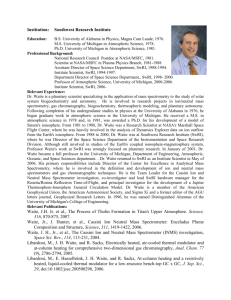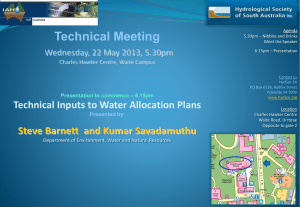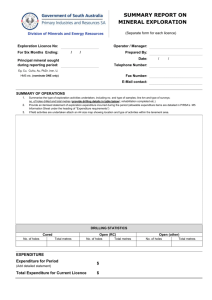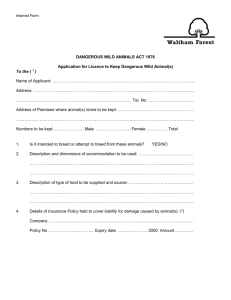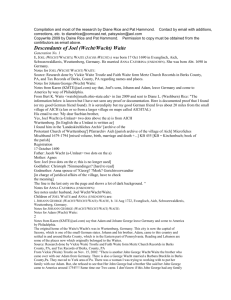EL26459_2009_A_01
advertisement
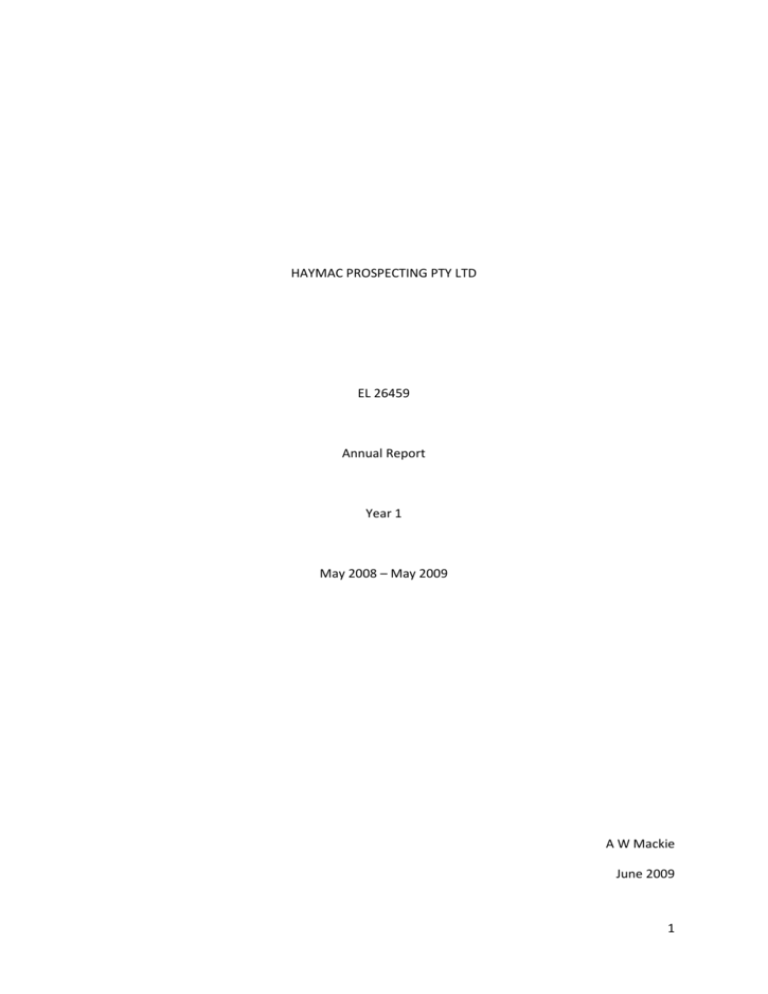
HAYMAC PROSPECTING PTY LTD EL 26459 Annual Report Year 1 May 2008 – May 2009 A W Mackie June 2009 1 CONTENTS Summary 1. 2. 3. 4. 5. 6. 7. 8. 9. 10. 3 Introduction Landuse and Tenure Location and Access Previous Exploration Regional Geology Prospect Geology Exploration Program Expenditure Conclusions and Recommendations References 4 4 4 4 6 7 9 10 10 10 Figures 1. 2. 3. 4. 6. 7. 8. 10. Cadastral Plan of EL 26459 Central –Arunta Total Count “Hot Spots” Central Arunta Regional Synthesis-Granites Central Arunta Basinal Synthesis EL 26459 Regional Geology EL 26459 Location Radiogenic Granites and Regional Drainage EL 26459 AMAG Interpretation 1 EL 26459 AMAG Interpretation 2 Ground Water Sampling Location Plan (After Summary) Appendices Appendix 1 ALS Water analysis results 2 SUMMARY EL 26459 is located on southeast ALCOOTA encompassing 118km2 of the Alcoota floodplain. Radiogenic granites crop out north east, north and north west of the licence area namely Woodgreen, Crooked Hole, Mt Ida, Copia and Mt Swan (1770 – 1710Ma). Terrestrial continental sedimentation in late Tertiary laid down a lacustrine/fluviatile sedimentary package approximately 250 metres thick, whose provenance is to the north of EL 26459 namely the above Palaeoproterozoic radiogenic granites. 80% of EL 26459 is underlain by the above late Tertiary early Pliocene Waite Formation (6-4Ma). Radiogenic acid intrusive rocks crop out in the Strangway Ranges to the south of EL 26459 namely Wuluma Granite and Ingula migmatite (1728Ma) which is also the origin or headwaters of the north northeast flowing Waite Creek – Sandover River system which has flooded out onto the Alcoota plain since the beginning of the Holocene 11500 years ago. The current active stream channel flows alongside the western boundary of EL 26459, however palaeochannels to the east are present under a thin layer of redsoil. The area under licence has potential for the discovery of sedimentary uranium deposits within recent calcrete-filled palaeochannels overlying Waite Formation and within the much thicker and older Waite Formation itself. Ground water analysed from Bore RN14245 showed elevated Uranium (26 ppb) and Phosphorus (1380 ppb). 3 1. INTRODUCTION EL 26459 is located on Delny 1:100 000 map sheet of the Alcoota 1:250 000 Geology sheet (1975). Eighty percent of the area under licence is underlain by interpreted Waite Formation of Tertiary to Pliocene age (65Ma - 4 Ma) comprising poorly indurated sandy siltstone and sandstone with broad intervals (intersected in drillholes) of fluviatile loose sand deposits interspersed with bands of chalcedonic limestone. Mesas capped by the more resistant chalcedonic limestone dominate the landscape locally rising up to 20 metres above the surrounding floodplain. The licence area is located north and northeast of uraniferous intrusive rocks cropping out in the Strangway and Harts Ranges whose major drainages merge to form the north northeast trending Waite Creek – Sandover River system on the flat-lying Alcoota floodplain part of which is within EL 26459. Uraniferous Palaeoproterozoic granitic intrusives also crop out northwest, north and northeast of the licence area and were until 5 million years ago the upland origin of south trending palaeodrainages which laid down the fluviatile facies of the Waite Formation interpreted to underly EL 26459. Thus the area is deemed prospective for sedimentary uranium deposits within both the older and considerably thicker Tertiary succession (120 metres plus) and Holocene to recent fluviatile deposits of the Alcoota floodplain. 2. LANDUSE AND TENURE EL 26459 was granted to A W Mackie for 6 years on 2 nd May 2008 comprising 118 graticular blocks (373.8kms2) of Alcoota Pastoral Lease which is now called Engawala owned by the Alcoota Aboriginal Corporation. The one graticular block-wide strip on the eastern boundary of the licence area is designated part of the Sandover Stock route. 3. LOCATION AND ACCESS EL 26459 is 185km by road northeast of Alice Springs. Access is via the Stuart Highway for 70km then east for 90km along the Plenty Highway until the turnoff to Alcoota Station then north for 26km to the homestead which is located in the southwest corner of the licence area. The area is well served with station tracks and roads making for easy access. The Sandover Stock Route on the eastern boundary of the licence area is fenced along its entire length with a well maintained track running alongside the fence. 4. PREVIOUS EXPLORATION 5 to 10km southeast of the licence area near Yam Creek Bore are the Undippa abandoned mica mines which operated from 1945 – 48 producing 17tons of muscovite valued at £18,940 (Joklik, 1955)). The ‘books’of muscovite occur in quartz-feldspar pegmatites hosted by a leucocratic biotitequartz-feldspar gneiss of the Palaeoproterozoic Irinidina Province, Harts Range Group. 45km to the northwest of the licence area copper mineralisation (disseminated chalcopyrite) within grey sandstones of the Neoproterozoic to Early Cambrian Central Mt Stuart Beds was discovered in 1965 near Mt Skinner (refer Figure 2 &3). In 1966 Kennecott Exploration mapped the area and 4 drilled 3 percussion holes. In 1969 the Mt Skinner Cu prospect was drilled by the Mines Branch Administration who intersected 6,500ppm Cu over 0.3 metres in DD3. In DD1 and 2 highest values were 2570 and 1880 ppm Cu over a metre respectively. Also in DD3 1.5 metres averaging 6700 ppm Pb at 132m was intersected. The first edition Alcoota 1:250 000 Geology map sheet was mapped in 1972 and published by the BMR in 1975. Three stratigraphic core holes namely SH1, SH2 and SH3 were drilled to test the thickness of the Tertiary sequence (refer Figures 2 and 3). SH1 located 10km southwest of the licence area intersected 105m of Waite Formation before being prematurely terminated in green silt and mudstone. SH2 was gamma-logged (55km west of the licence area) recording an anomaly of twice background from 90 – 100 metres within a sandy conglomerate unit believed to be due to “low concentrations of soluable uranium compounds in groundwater”. The BMR also gamma-logged Woodgreen No1, RN56 (35km NW of the licence area, refer Figure 2). A three-times background gamma anomaly was detected over the interval 24 – 38 metres within a medium grained sandstone unit extending through the zone of oxidation. The interface between oxidised and reduced zones is considered favourable for the concentration of uranium in a sedimentary environment. The Bundey River tantalite prospect 25km northwest of the licence area only produced one tonne of tantalite, however the reported presence of the uraniferous amorphous phosphate mineral, griphite maybe significant. Likewise the Utopia tantalite prospect 40km north of the licence area is a weakly radioactive tourmaline, muscovite, feldspar, quartz pegmatite (refer Figure 3). In 1973 CRAE Exploration conducted a shallow auger drill hole program testing surface calcretes within palaeochannels mainly in the northwest quadrant of ALCOOTA. Uraniferous water samples were obtained from calcretes at 8 Mile Well and Prices Well returning assay values of 226ppb and 54ppb U respectively. They also tested a shallow calcrete in the general vicinity of 720 Bore, 10km west of the licence area. In 1978 Otter exploration flew a radiometric survey over the Red Cliff granite area (30km west of the licence area) delineating 5 anomalies. Two of which namely RCA1 and RCA2 were found to be weakly uraniferous “garnet granite” assaying 50ppm and 80ppm U respectively. Red Cliff granite is the orthogneiss (PEg) 29km due west of SH2 on Figure 2. In 1997 the NTGS flew the high resolution Alcoota – Alice Springs 500m line space geophysical survey. Figure 1 is a summary of the radiogenic granites or “Hot Spots” delineated by the above. On ALCOOTA the following are considered potential uranium sources for sedimentary uranium deposits within EL 26459, Woodgreen Granite, Copia Granite and Mt Swan Granite. On ALICE SPRINGS the Wuluma Granite and the Ingula migmatite are highly uraniferous, cropping out as they do in the headwaters of the NNE – trending Waite Creek-Sandover River system which has flooded out over EL 26459 since the beginning of the Holocene, 11500 years ago. They are considered potential sources for calcrete-hosted palaeochannel deposits which may occur beneath the present red soil regolith profile above the underlying Waite Formation? 5 Nolans Bore apatite vein-hosted REO, Phosphate, Uranium deposit was discovered in 1999-2000 by Arafura Resources. The repealing of the Federal Governments’ Three Uranium Mine policy in 2003 led to a flurry of exploration activity particularly in the NT which was declared “open for business’’ by Canberra. Several IPO’s raised capital to participate in the uranium boom focussing on the Titri Basin namely Nupower, Uramet, Thor Mining, Deep Yellow and Western Desert Resources. Nupower has flown the southern part of the Titri Basin with airborne electromagnetics delineating prospective palaeochannels beneath the Hanson Plain. Likewise Uramet who are testing the calcrete-filled northwest trending palaeochannel which commences 15km west of EL 26459 continuing for over 100km to the northern margin of the Titri Basin (refer Figure 3). The New Well calcrete-hosted deposit contains 1,420 tonnes U308 located 180km west of EL 26459 (refer Figure 2). Thus enhancing the prospectivity of the Titri and Waite Basins for shallow calcrete-hosted sedimentary uranium deposits of which Langer-Heinrich in Nambia is the largest i.e. 80.5mt averaging 600ppm U308 for 143,500 tonnes. 5. REGIONAL GEOLOGY (Figure 2 & 3) EL 26459 is located in the southeast quadrant of the Alcoota Geology map sheet and includes elements of the late Palaeoproterozoic Aileron Province, Neoproterozoic to Palaeozoic Irindina Province and the Cenozoic Waite Basin. The Mt Bleechmore massif is exposed to the southwest comprising Bleechmore Granulite with a maximum depositional age of 1800Ma. The lower metamorphic grade equivalents of Bleechmore Granulite namely Delmore and Delny Metamorphics crop out to the northeast and north of EL 26459. Cropping out to the west are extensive exposures of Kanadra Granulite a time equivalent of the Bleechmore Granulite. Protoliths to the granulites ar relatively thick sequences of felsic and mafic volcanics. They are the oldest rocks in the area and are assigned to the Strangways Metamorphic Complex. The amphibolite grade Delmore Metamorphics are comprised of cordierite-anthophyllite metapelite and volcaniclastic protoliths interpreted as a pre-metamorphic regional alteration assemblage. Immediately southeast of EL 26459 are cropping out pelitic calcareous, psammitic and felsic gneisses of the Harts Range Metamorphic Complex. The Ledan package (including the Mendip Metamorphics which crop out locally) are part of a cover succession deposited between 1760 and 1740Ma. A tectonothermal event affected the area between 1735-1690Ma namely the Strangways Orogeny which metamorphosed Bleechmore and Kanandra protoliths to granulite facies and their lesser equivalents to amphibolitie facies. It also involved the intrusion of voluminous granite. The Woodgreen Complex, Mt Ida and Mt Swan granites cropping out to the northeast, north and northwest of EL 26459 were generated during the Strangways Orogeny broadly synchronous with localised high-temperature, low-pressure metamorphism and partial melting of metasedimentary rocks. The Woodgreen, Mt Ida and Mt Swan granites have SHRIMP ages of 1713 Ma and are assigned to the High Heat Production group (HHP) intruded from 1730 – 1710 Ma enriched in Th, U, Rb and LREE. The other groupings of granites in the area are an older group which were intruded from 1780 – 1750 Ma namely the Main Group which locally includes the Copia Granite (1770Ma) and the Crooked Hole Granite. It also includes Queenie Flat Granite (1770Ma) which crops out immediately 6 southeast of EL 26459 intruding Hart Range Group metasediments (refer Figure 2). The HHP group is formed by the remelting of Main Group granitoids however it is interesting to note that both the Crooked Hole and Copia granites are highly radiogenic. The Irindina Province Harts Range Group metasediments underwent further thermotectonism from 490 – 460Ma where metamorphic grades reached transitional granulite facies during the postulated Larapinta Event. Generally the region underwent episodic tectonism during the Palaeozoic Alice Springs Orogney (450 – 360Ma). It was cut by major west-northwesterly high-angle reverse fault/shear zones resulting in exhumation of basement and erosional removal of Georgina Basin rocks across the southern half of ALCOOTA. The Entire Point Shear Zone which separates the Irindina Province HRG from the Aileron Province in southeast Alcoota has an activation SHRIMP age of 445Ma. There is no evidence of preserve sediments from after the Alice Springs Orogeny (300Ma) until terrestrial sedimentation spread over much of ALCOOTA in the early Tertiary (65Ma). Mild uplift accompanied the onset of widespread fluviatile and lacustrine sedimentation over a partly truncated deep weathering profile. During the Late Pliocene or Early Pleistocene uplift occurred along the site of the present Strangway and Harts Ranges producing a reversal of drainage in the eastern part of ALCOOTA from a southerly to a northerly direction. 6. PROSPECT GEOLOGY (Figure 4 and 6) Felsic Bleechmore Granulite crops out in the northwest corner of EL 26459 where it is surrounded by deeply weathered Tla comprising leached mottled and ferruginous partly kaolinitic and pisolitic laterite. The remaining 80% of the licence area is underlain by Tw (Waite Formation). Cenozoic rocks in southeast Alcoota include: 1. Laterite developed on Aileron Province basement – Tla 2. Lacustrine and fluviatile sediments – Tw Most observable cropping out Tla and Tw are restricted to a dissected area in southeast ALCOOTA (includes EL 26459) where an east-west depression bounded to the south by Harts Range contain up to 180 metres of Tertiary sediments. The depression is called Waite Basin and the cropping out sediments Waite Formation. Similar sediments occur in central and central-west ALCOOTA, however they do not crop out instead covered by low sandy soil mantled rises (known from drill hole logs). The sediments have not been uplifted and dissected like Waite Basin exposures. Deep chemical weathering during early Tertiary – late Cretaceous (70 – 50Ma) altered the upper 40 metres of exposed Aileron Province basement to laterite in a typical tri-zonal arrangement comprising; Lower-most leached zone Intermediate mottled zone Ferruginous top zone 7 On ALCOOTA a widespread laterite terrain developed prior to Miocene (23-5.33Ma) followed by a period of erosion, stripping laterite from most of the area some of which is now incorporated in Waite Formation which now covers the completely or partly eroded surface. In places a complete laterite profile is preserved below Waite Formation allowing detailed observation which shows the formation of laterite involves firstly rock decomposition followed by the liberation of alkali and alkaline ‘’earth metals’’ i.e. K, Na, Ca, Mg and silica then concentration of iron, aluminium oxides and hydroxides. Iron oxides increase upwards reaching 40% or more in the ferruginous zone. The Alcoota Beds as they are informally known (Senior, 1972) include Ta, Tw and TQt have a composite thickness of 250 metres inferred from drillholes (BMR Alcoota, SH1, SH2, SH3, refer Figure 3). The basal mudstone and siltstone sequence (Ta) is only exposed over 5 metres along the Plenty River valley whereas Waite Formation (Tw) crops out extensively as Mesa escarpments in a belt roughly peripheral to the margins of the Waite Basin in southeast ALCOOTA. It unconformably overlys a partly truncated laterite developed in late Palaeoproterozoic rocks. TQt the youngest Alcoota Beds are represented at surface by a few metres of quartzose sand and chalcedonised chemical and clastic sediments. The BMR Alcoota scout holes namely SH1, 2 and 3 show there is a relatively thick pile of Tertiary sediments in southeast ALCOOTA with sedimentary uranium potential i.e. 1. Sediments derived from nearby late Palaeoproterozoic basement which have abundant acid, plutonic, radiogenic source rocks. In relation to EL 26459 they include Woodgreen, Crooked Hole, Copia and Mt Swan granites (Figure 2) 2. Alternating coarse and fine grained Tertiary sediments deposited under fluviatile and lacustrine conditions. 3. Sediments have a variety of red, white and green zones the result of differentiation under oxidising and reducing conditions. Unit Ta BMR Alcoota SH1 and 2 intersected a massive mudstone and siltstone sequence below Tw. Neither hole had drilled through it when terminated. The upper part of the argillaceous sediments are weathered and mottled stained by red oxide. In SH2 there is a zone of slightly leached white mudstone and siltstone grading into a basal sequence of green to grey unaltered pyritic mudstone. The sediments are devoid of bedding except for a few faint laminations indicating they were deposited in a lacustrine environment of very quiet water under reducing conditions. Tw Waite Formation About 40 metres of Upper Waite Formation crops out on southeast ALCOOTA nowhere is the full thickness exposed. SH3 intersected 130 metres of sandstone, siltstone and mudstone deemed Tw, 30km southwest of EL 26459. In outcrop Tw comprises interbedded chalcedonic limestone, sandstone, siltstone and sandy conglomerate. Beds of cream to white chalcedony form hard, resistant summit caps to many flat-topped mesas. The multiplicity and lack of clastics within the chalcedonic beds indicate they formed by direct precipitation of silica and are contemporaneous with interbedded clastic deposits of Waite Formation. Some beds have the appearance of 8 limestone. Secondary replacement of calcium by silica may have occurred. chalcedonic limestone retuned the following; XRF analysis of Silica 96.7% Ironoxide 0.77% Calcium oxide 0.35% Phosphorous pentoxide 0.25% In most outcrops of Tw grain size increases upwards perhaps indicating a transition from a lacustrine to a fluviatile environment of deposition. Vertebrate fossils found in cropping out lacustrine parts of the sequence are late Miocene to early Pliocene (6 – 4Ma). The distribution of Tertiary sediments shows two north-trending extensions of the Waite Basin. At about 10km south of Utopia on the western most extension, coarse-grained sediments occur with pebble to small boulder sized clasts. The linearity and coarseness of these deposits in conjunction with a probable decrease in grain size southwards indicate a northerly source of detritus with drainage flowing southward into Waite Basin. This constitutes a reversal of the modern drainage direction consequently the Waite Basin was uplifted and dissected after the early Pliocene (5.33 – 1.8Ma). 7. EXPLORATION PROGRAM (Figures 4, 6, 7, 8, & 10) The located digital AMAG and Radiometric data from the 1997 Alice Springs – Alcoota Geophysical Survey was acquired, processed and appropriate colour images produced. Figure 4 shows the Kchannel dispersal of the Waite Creek-Sandover River system in relation to EL 26459 as if flows out over the Alcoota flood plain from its highly radiogenic source area the Wuluma Granite and Ingula migmatite in the Strangway Ranges. Figure 6 shows the extent of inferred radiogenic granite as indicated by the K channel namely Woodgreen, Crooked Hole, Mt Ida, Copia and Mt Swan Granites. Clearly there are abundant radiogenic source areas to the NE, N and NW of EL 26459 of Palaeoproterozoic age to facilitate the movement of soluble uranium in conjunction with the laying down of Miocene? Waite Formation fluviatile sediments. Figures 7 and 8 are AMAG interpretations of southeast ALCOOTA centred on EL 26459. The southeast corner of the licence area straddles the Entire Point Shear Zone which separates Irindina Province HRG rocks from Aileron Province Strangways Metamorphic Complex Bleechmore Granulite. The hi-mag units within EL 26459 are interpreted as mafic granulite of the Bleechmore Granulite both the Mt Swan and Mt Ida Granites are highly magnetic north of the Delny Shear Zone in contrast to the Copia, Woodgreen and Crooked Hole Granites. The Waite River Fault or Shear Zone transects the licence area of probably ASO age. Figure 10 shows the location of water samples collected from six bores and analysed for Uranium, Thorium, Potassium, Cerium, Lanthanum and Phosphorous relative to Woodgreen, Copia and Mt Swan radiogenic granites. 9 8. EXPENDITURE Desk Top Studies and literature research Geophysical data acquisition & image processing Drafting Consultant Sampling Program Analytical costs Geological Time Administration 10% $ 5,000.00 5,000.00 6,000.00 2,000.00 1,000.00 15,000.00 3,400.00 $37,400.00 9. CONCLUSIONS AND RECOMMENDATIONS Palaeochannels beneath the redsoil mulga covered floodplain (above underlying Waite Formation) are easily delineated by airborne electromagnetics. They could also be located by a relatively cheap vacuum rig drilling program traversing across the licence area from east to west on 50 metre centres (traverses 100 metres apart) over discernable flood plain areas. Once a palaeochannel has been intersected by a vacuum hole, drill spacing can be closed up to delineate its size and extent and the presence of prospective calcrete deposits. Drill testing of the underlying Waite Formation requires several east-west fences of vertical RAB drillholes to depths below the Tw/Ta interface where oxidising conditions pass through a transitional zone into underlying reducing conditions. The thickness of the Waite package is not known locally, however best-guess estimate of 120 metres is reasonable. If roll-front uranium mineralisation is present within Waite Formation it will occur at the above interface. In view of the large cropping out extent of radiogenic granites on ALCOOTA a regional groundwater sampling program would be a useful exploration tool to vector on prospective areas of uranium mineralisation. 10. REFERENCES Senior, B.R., 1972 Cainozoic laterite and sediments Alcoota NT BMR Record 1972/47 (unpublished) Shaw, R.D., Warren. R.G., 1975 Alcoota 1:250,000 Geological Map series – Explanatory Notes O’Farrel, D., 2008. Bralich Pty Ltd Info. Memo EL 25504 Alcoota Map Sheet Kojan, C.J., 1978 Final Report EL 1456. Otter Exploration NL NTGS O/F CR 78/143 NTGS 2009 Radiometric Map of NT ASX Quarterly Reports – Nupower (NUP), Toro Energy (TOE), Deep Yellow (DYL), Western Desert Resources (WDR), Uramet (URM) Beyer, E., Edgoose, C., Vandenberg, L., Bordokes, S., 2008, Preliminary investigations in the Central Arunta Region. AGES 2008 PP Presentation 10 Scrimegour, I., 2006 Woodgreen 100k Geology Map Sheet – Explanatory Notes NTGS 100k Map Series 11
